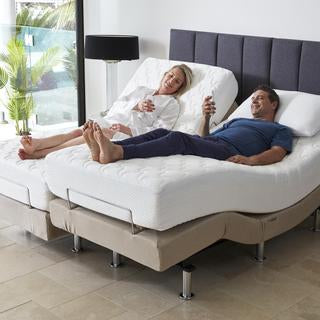Trying to sleep with lower back pain can be a horrible experience. Not only can it be deeply uncomfortable but you’re unlikely to get much sleep. This can make the problem even worse as you’re tired and unable to recover.
Thankfully, there are things you can do to help. Here we take a look at what the causes are, how to treat it and what else you can do to make your life easier. Soon you'll be able to get a much more restful night of sleep.
What Causes Lower Back Pain When Sleeping?
Lower back pain after sleeping is usually caused by poor sleeping positions that put pressure on your spine forces it into unnatural positions. Other causes can include a bad mattress or a condition such as disk degeneration or fibromyalgia.
There is a range of sleeping positions that will stop you from getting back pain and we'll shortly look at them in more detail. Troublesome positions are usually ones that don't give you proper alignment as you either have a slight twist of your body or your back is too flat, or too straight.
That alignment can be made worse by having a soft mattress. This can happen if you’ve had a mattress for a long time. The reason for your bad back, however, may be more sinister and if you think you have a problem then you should speak to your doctor.
How to Treat Back Pain While Sleeping?
You need sleep for your body to recover and to do that you need to be in the proper position. A good night of sleep in the right position will take stain away from your back and allow you to wake up pain-free.
Change Your Sleeping Style
Often people have their favorite way of sleeping but this may be causing your back issues. If you want to relieve your back issues then you need to consider changing your sleeping style. If you're used to sleeping a specific way then this may feel a bit weird at first but you should persevere with it as it'll soon feel much more normal.
Why Your Mattress May Be Causing Back Pain
We’ve talked a lot already about alignment and it can be very hard to get into a good position if your mattress is old and too soft. The best mattress for people with lower back pain is one that is in the medium-firm to firm range. This will give your body enough comfort while still giving your back sufficient support.
Create a pre-bed routine
You shouldn’t just leave it to your sleeping position and mattress. There are other ways you can improve your back health. Getting into the right routine before you get in bed can pay dividends when you get out of it in the morning.
Stretch before bed
There are numerous stretches you can do before bed and here are a few great examples. These can help to relieve any tension and prevent any pressure points from bothering you. It will also help to loosen your back muscles and allow you to get into better sleeping positions.
Get the right amount of sleep
Sleep is important for many reasons. It helps to regenerate any damaged tissue, reduce inflammation in the body, increasing your energy reserves and also allows your spine to recuperate and decompress. This is added to all the regular benefits of a good night's sleep.
Improve your posture
The root cause of your back pain may be bad posture. There are easy ways to improve your posture and it can have transformative effects. Improving your posture can help to reduce pressure on your back and by the time it comes to sleep, you’ll be able to rest much easier.
Managing Back Pain Reduces It Over Time
You have to treat your back with care. If you have bad habits now then that pain is only going to get worse as you get older. It can sometimes be hard to get rid of back pain but if you put the right practices in place, it can reduce over time. We’ve looked at a few different solutions here and it’s a good idea to combine them for an effective solution.
Sleeping Positions To Reduce Back Pain
There are a few great sleeping positions for back pain and here we take a look at the four best.
On your side with a pillow – If you like sleeping on your side then do so with a pillow between your legs. This helps to keep your hips in alignment and thereby takes pressure away from your spine.
Fetal position – Tucking your knees up into your chest while you feel on your side can make sleeping much easier. This can loosen up your spine and take pressure away from your spinal discs.
On your front with a pillow – Front sleeping is usually bad for back pain but this can be avoided with a pillow under your lower abdomen. It's best to only use a small pillow for your head as otherwise, this may cause neck pain.
On you back with a pillow – If you prefer to sleep on your back then do so with a pillow under your knees. This will help with your alignment and evenly spread your weight across the bed.
FAQs
Can a bed make your lower back hurt?
Absolutely. This could be due to a bed that is either too soft or too firm. With older mattresses, it could also be that the springs and/or foam have shifted from their proper position and it’s no longer giving you the right amount of support.
Can your back hurt from laying down too much?
With too much rest your body can become stiff and you can lose flexibility. While sleeping is important, you also want to get up and be active. Stretching and using the correct posture can relieve back pain when you’re out of bed.
What is the healthiest sleeping position?
There isn't one magic sleeping position. It's simply important to keep your back and hips aligned. Many find this easiest to do on their back and hardest to do on their front. If you practice one of the positions we looked at earlier, you'll be fine.
This document was edited with the instant web content composer. Use the online HTML converter to convert the documents for your website.



